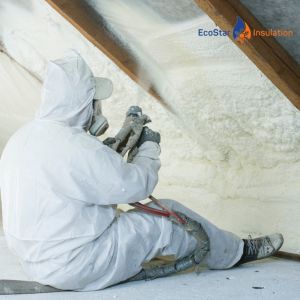How Spray Foam Minimizes Water Damage
Spray foam insulation has all the right properties to properly protect your home or business from water damage. Installation is quick and easy, with almost no maintenance needed. Spray foam insulation costs are low when compared with other insulation materials making this the ideal insulation to protect your property from water damage and subsequent problems that follow water damage. EcoStar is the leading insulation company that will help you through the installation process.
This article looks at how spray foam insulation minimizes water damage.
How Spray Foam Insulation Protects Against Water Damage
 Spray Foam operates by sealing any gaps or cracks in your walls, floors, or ceilings, preventing water infiltration, and creating an optimal environment to inhibit mold growth. As spray foam insulation is formulated as a closed-cell insulating material and, in essence, has waterproofing properties, it deters water penetration. Spray foam insulation stands out as the sole insulation type capable of effectively preventing external moisture infiltration. Fibreglass insulation and similar alternatives lack the capacity to offer a sufficient barrier, resulting in gaps that permit moisture ingress. Additionally, these alternative insulations may even absorb moisture.
Spray Foam operates by sealing any gaps or cracks in your walls, floors, or ceilings, preventing water infiltration, and creating an optimal environment to inhibit mold growth. As spray foam insulation is formulated as a closed-cell insulating material and, in essence, has waterproofing properties, it deters water penetration. Spray foam insulation stands out as the sole insulation type capable of effectively preventing external moisture infiltration. Fibreglass insulation and similar alternatives lack the capacity to offer a sufficient barrier, resulting in gaps that permit moisture ingress. Additionally, these alternative insulations may even absorb moisture.
Identification of Water Damage Risks
When trying to identify water damage, you should look out for the following signs.
- Unpleasant musty odours.
- The onset of mold growth, typically initiating at the joints of floors and ceilings.
- Unexpected spikes in your water usage charges.
- Visible stains or discoloration.
- Musty odours persisting.
- Warping, bending, or irregular shapes in walls, ceilings, or floors.
- Paint or wallpaper peeling.
Mold and mildew following water damage flourish in damp surroundings, making mold one of the prevalent consequences of concealed water damage. Additionally, deteriorating wood and foundation issues are frequently encountered. Should a home's foundation be compromised or unstable, it may lead to significant and costly complications in the future and put inhabitants at serious risk of injury.
Preparation for Spray Foam Insulation
Step 1 – Assessing Home Areas
We collaborate with our clients to identify which parts of the home require access and the type of materials homeowners should prepare. Some areas where we commonly install spray foam insulation include:
- Attics
- Crawl spaces
- Garages
While we aim to work efficiently without disrupting your daily routine, our team requires clear driveways, hallways, and stairwells to access these designated spaces effectively with our equipment.
Step 2 – Clearing the Space
We kindly request that all rooms be as free of items as possible. This ensures ample space for our teams to work and helps keep your belongings clean and free of spray foam.
Step 3 – Locating Electrical Outlets
Our team will assist in identifying all electrical outlets in the areas designated for spray foam installation. However, we appreciate homeowners' assistance in locating any hard-to-find outlets. This helps ensure that each outlet is properly secured with spray foam without being entirely covered.
Step 4 – Sealing Air Leaks
While spray foam insulation naturally serves as an air barrier, sealing up small crevices and gaps, we ask that larger air leaks be addressed before installation. If you have any questions about a specific area, feel free to consult with our spray foam experts!
Installation of Spray Foam Insulation
The recommended approach for insulation involves using spray foam insulation to fill the voids between the framing studs in both walls and attics. Hiring a professional insulation company, such as EcoStar, guarantees you the job is done correctly, giving you peace of mind.
Begin by conducting a test spray. Since the material expands significantly (about 100 times its initial volume), it's prudent to test it cautiously until you grasp how it fills in. Keep in mind that closed-cell spray foam needs to be one to two inches thick to achieve the desired R-value. Spray the foam evenly between the studs and onto the backside of the exterior sheathing. Allow it ample time to expand and fill all the gaps. Allow the foam to fully form and set. Trim away any excess foam that protrudes beyond the studs. Use a handsaw or blade to remove any raised foam, ensuring it is flush with the studs. This step is crucial as the foam will not compress and could pose an obstacle during the drywall installation process.
Maintenance of Spray Foam Insulation
Spray foam insulation is projected to last anywhere from 80 to 100 years, requiring minimal to no maintenance, saving you in time and in spray foam insulation costs. Its durability ensures it can endure as long as your building stands. Unlike cellulose and fibreglass, spray foam does not degrade, droop, or settle over time.
Leaders in Insulation Installation, EcoStar
Trust the leaders in the insulation industry, EcoStar. They have the necessary expertise, skills, and equipment to install insulation correctly, protecting your home from water damage and potential mold spread. Put your family, loved ones, and property first by investing in EcoStar’s professional services.



